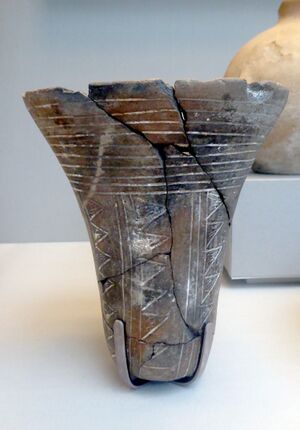ثقافة دير تاسا
| النطاق الجغرافي | صعيد مصر |
|---|---|
| الفترة | العصر الحجري الحديث |
| التواريخ | ~4,500 ق.م. |
| الموقع النمطي | دير تاسا |
| السمات | معاصرة لكل من ثقافة البداري، ثقافة مريمدة |
| سبقها | ثقافة الفيوم أ |
| تلاها | ثقافة البداري، Amratian culture |
| الأسر الفرعونية بمصر القديمة |
| مصر قبل الأسرات |
| عصر نشأة الأسرات |
| عصر الأسر المبكرة |
| 1 - 2 |
| الدولة القديمة |
| 3 - 4 - 5 - 6 |
| الفترة الانتقالية الأولى |
| 7 - 8 - 9 - 10 - |
| 11 (طيبة فقط) |
| الدولة الوسطى |
| 11 (كل مصر) |
| 12 - 13 - 14 |
| الفترة الانتقالية الثانية |
| 15 - 16 - 17 |
| الدولة الحديثة |
| 18 - 19 - 20 |
| الفترة الانتقالية الثالثة |
| 21 - 22 - 23 - 24 - 25 |
| العصر المتأخر |
| 26 - 27 - 28 |
| 29 - 30 - 31 |
| العصر الإغريقي والروماني |
| بطالمة - الإمبراطورية الرومانية |
ثقافة دير تاسا Tasian Culture (ح. 4800 ق.م.) وهي قرية صغيرة على الشاطئ الشرقي للنيل بمركز البداري بمحافظة أسيوط. حضارتها قامت حوالي 4800 ق.م. وكان الموتى يكفنون في جلود الحيوانات والحصيرة وكانوا يدفنون ناظرين تجاه الغرب ومن مميزات تلك الحضارة صناعة الفخار الأسود. وهذه الحضارة سابقة لحضارة البداري، إلا أن البعض يدمجهما في حضارة واحدة، للقرب الجغرافي، بالرغم من أن حضارة دير تاسا تنتمي بالكامل للعصر الحجري، بينما تميزت حضارة البداري باستخدام النحاس.
The Tasian culture group is notable for producing the earliest black-topped pottery, a type of red and brown pottery, which has been painted black on its top and interior.[1] This pottery is vital to the dating of the various predynastic Egyptian civilizations. Since all dates for the Predynastic period are tenuous at best, Flinders Petrie developed a system called Sequence Dating through which the relative date, if not the absolute date, of any given Predynastic site can be ascertained by examining the handles on pottery.
As the Predynastic period in ancient Egypt progressed, the handles on pottery evolved from functional to ornamental, and the degree to which any given archaeological site has functional or ornamental pottery can be used to determine the relative date of the site. Since there is little difference between Tasian and Badarian pottery, the Tasian Culture overlaps the Badarian place on the scale between Sequence Dating 21 and 29 significantly.[1][2]
Excavations of Tasian burials have yielded a number of skeletons. The fossils are generally taller and more robust than later predynastic Egyptian specimens. In this regard, the Tasian skeletons are most similar to those associated with the Merimde culture. Furthermore, although the Tasian crania are dolichocephalic (long-headed) like many of the other predynastic skulls, they have a large and wide vault like the Merimde crania. Skulls excavated from Badarian, Amratian, and Natufian sites tend instead to be smaller and narrow.[3]
Archaeological evidence has suggested that the Tasian and Badarian Nile Valley sites were a peripheral network of earlier African cultures that featured the movement of Badarian, Saharan, Nubian, and Nilotic populations.[4] Bruce Williams, Egyptologist, has stated "The Tasian Period is significantly related to the Neolithic of Sudanese-Saharan tradition as found just north of Khartoum and near Dongola in Sudan".[5]

. . . . . . . . . . . . . . . . . . . . . . . . . . . . . . . . . . . . . . . . . . . . . . . . . . . . . . . . . . . . . . . . . . . . . . . . . . . . . . . . . . . . . . . . . . . . . . . . . . . . . . . . . . . . . . . . . . . . . . . . . . . . . . . . . . . . . . . . . . . . . . . . . . . . . . . . . . . . . . . . . . . . . . . .
المصادر
- ^ أ ب Gardiner, Alan (1964). Egypt of the Pharaohs. Oxford University Press. pp. 388, 389.
- ^ Grimal, Nicolas (1988). A History of Ancient Egypt. Librairie Arthéme Fayard. p. 35.
- ^ Forde-Johnston, James L. (1959). Neolithic cultures of North Africa: aspects of one phase in the development of the African stone age cultures. University of California. p. 58. Retrieved 16 June 2016.
- ^ Egypt in its African context : proceedings of the conference held at the Manchester Museum, University of Manchester, 2-4 October 2009. Oxford: Archaeopress. 2011. pp. 43–54. ISBN 978-1407307602.
- ^ Williams, Bruce (1996). "The Qustul Incense Bruner and the Case for a Nubian Origin of Ancient Egyptian Kingship" In Egypt in Africa. Celenko, Theodore (ed.). Indianapolis, Ind.: Indianapolis Museum of Art. pp. 95–97. ISBN 978-0936260648.
- ^ "Beaker British Museum". The British Museum (in الإنجليزية).
